The Windstorms of Nov 14, Year 1981 When I came home on that fateful Friday [the 13th] the pressure was 29.21 inches and falling. I suspected there would be a windstorm [a lesson learned from the February 1979 storm]. So I called Dad and told him. Then I went outside for a walk in The Forest [a greenbelt to the east of my condominium home] and that's when I thought about listening to the weather-radio. So I ran home and turned it on. It said: There is a major low pressure center off the coast of California and we would experience winds of 40 to 50 miles per hour with occasional gusts higher. Bring all loose objects such as garbage cans, lawn chairs, etc. inside. I waited all day and through the evening for the storm to hit. All it did was just get cloudier. Then at 12:00 AM the wind was dead calm. We (Derek [my older brother], Dad, and Me) were watching TV at the time [some kung-fu movie]. Two gusts hit, only two. I estimate them to be around 25 mph. Then it got dead calm again and the pressure stood at 28.98 inches and falling. After that we went to bed. I left the bedroom window open so we could hear the wind. In the morning Derek woke me up and I heard the wind blowing through the cottonwood trees. It was 7:34. I walked into the livingroom and turned the TV to Channel 18 [community ads and local weather] and watched the wind speed slowly diminish from 36 to 26 mph. I got the newspaper out and read about the windstorm. It said that 1 person was killed and the wind blew well over 50 mph. The last paragraph said that a second windstorm was coming. So I listened to the weather-radio and it said that the winds would start to blow 35 to 45 miles per hour with occasional gusts higher as the second windstorm hit.
[Page 3 is missing-lost to the vagaries of time, I suspect, so I will fill in directly from the weather journal, then resume at the top of page 4.] ...Then I went to Thunder Hill [apartments] to see what happened there. The Poplar [a huge black cottonwood near the street] lost four 8-foot-long branches. I walked down the small hill and noticed a fallen dead Douglas fir [it was needle-less]. I turned around and saw a fallen alder tree split at the 5 foot level [pictured below, to the right]. I went home to tell Dad about what had happened.
[Back to the typed book:] ...ting gustier and large cold raindrops were blowing down, but they were horizontal. I sat on my bike for a while then I went home. The wind calmed a little (I got pictures during the time). Then after awhile the winds started to pick up again. I went back up to The Forest again and saw a tree lying across the rocks. It was an alder. After I checked the alder I climbed the fence and found a pussy willow tree snapped there too. I came back home and told Derek about the tree. So he came back up with me and took a look.
At home, the wind ripped through our chimney and slammed into our building. The roof was creaking and groaning in the heavy gusts and the sky was covered in a thick mantle of gray. The cottonwoods [in The Forest] were bending, swaying and cracking as the uncaring wind ripped across the sky. I watched a hemlock lose some of its large branches as the wind blew. Twigs from the cottonwoods blew all over the place and landed everywhere. Leaves blew hundreds of feet into the air and some whipped along the ground as the 50 mile-per-hour wind whipped the area. The storm was finally upon us. After awhile of watching TV, listening to the roof crack and watching branches falling off the trees, Eric [my best friend] came over. We decided to go to Eric's Forest [a woodlot behind his townhouse with a creek running through the middle]. It had lots of Douglas firs and alder trees in it and it was the peak of the storm, so why not?
Before night fell I checked the forest one more time. Another tree fell. It was a birch. That night on the news they said another windstorm was coming. I never knew if it hit but I think it died before it did. THE AFTERMATH The damage was almost unbelievable. Eight people killed [maybe less than this] in Washington, houses smashed, cars crushed, power out, windows shattering, but I will not get into that area. Here is what happened in the power lines and the surrounding area: Five trees were felled on our block and over fifteen lost their tops. No tree that fell on our block caused any damage. But the wind damage is a different story. The wind blew shingles off of the roofs and hurled them into walls and windows (causing some of them to break). A Plexiglas covering over the stairs of the "A" building was completely shattered. I don't know how much it cost to repair one of those but it must have been a lot. The forest damage was great, too.
In the Power Lines there was a part that was so wind-torn one tree was cracked three ways in a zigzag fashion. The Power Lines lost over fifty trees. In a forest by Phillip Arnold Park the storm nearly damaged every tree. In the park, a birch fell and so did two maples. Branches and leaves covered the ground. The forest [east of the park] was laid waste. Hemlocks, maples, (and I mean big maples) alders and Douglas firs were either snapped or uprooted. One hemlock was uprooted and it left a 4 ft. deep hole in the ground. Another hemlock snapped at the 20 foot level [pictured to left] and fell on a maple, shearing all the branches off. [It is noteworthy that most of these large falls occurred along the edge of a woodlot that was being cleared for a new subdivision--these trees used to be sheltered by others, and so their root systems were probably not as prepared for high wind as they might have been.] The End |
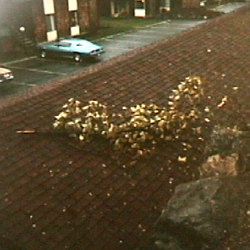 Then I went outside to see what damage the windstorm
did. I headed to The Forest first. Since the four cottonwoods
in the southeastern corner of the complex were by my path I
checked them first. Two large branches were cracked off them
but no trees were blown over. Then I walked to The Forest.
I walked on the path that headed to the fort, nothing but a
few alder branches down. Then I walked through the fort and
along the path that was by the fence. A large cottonwood branch
was lying there, a long one. It was about 15 ft. long and 6
inches in diameter. I walked the full length of the trail noticing
twigs and branches stuck in the fence and all over the ground.
I turned left to get on the rock by the carports. There was
another large cottonwood branch that was snapped off. It was
lying on the carport roof [pictured to the left]. I walked
south back up the rocks and climbed the fence to get in the
other part of The Forest. No trees down there either. So I
began to think the storm wasn't so strong...
Then I went outside to see what damage the windstorm
did. I headed to The Forest first. Since the four cottonwoods
in the southeastern corner of the complex were by my path I
checked them first. Two large branches were cracked off them
but no trees were blown over. Then I walked to The Forest.
I walked on the path that headed to the fort, nothing but a
few alder branches down. Then I walked through the fort and
along the path that was by the fence. A large cottonwood branch
was lying there, a long one. It was about 15 ft. long and 6
inches in diameter. I walked the full length of the trail noticing
twigs and branches stuck in the fence and all over the ground.
I turned left to get on the rock by the carports. There was
another large cottonwood branch that was snapped off. It was
lying on the carport roof [pictured to the left]. I walked
south back up the rocks and climbed the fence to get in the
other part of The Forest. No trees down there either. So I
began to think the storm wasn't so strong...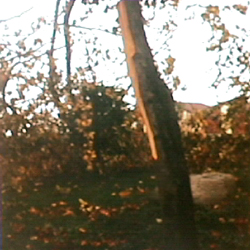 After Dad left to run I went outside back down
to Thunder Hill to look at the damage again. The second windstorm
was coming upon me now. As I rode down there I noticed something
was missing. The giant Poplar had crashed down and was lying
flat against the sidewalk [pictured straight below]. I rode
down the road through Thunder Hill and noticed a pussy willow
tree almost fell across the road. It was suspended over the
road by other alder trees. I rode down lower. Almost at the
end of the road and I saw a small Douglas fir blocking half
the road. I went home to tell Derek and Mara [my younger sister]
about the Poplar tree. After I told them, I went back outside
to watch the workmen saw the branches off the Poplar tree.
Now the second windstorm was upon us...
After Dad left to run I went outside back down
to Thunder Hill to look at the damage again. The second windstorm
was coming upon me now. As I rode down there I noticed something
was missing. The giant Poplar had crashed down and was lying
flat against the sidewalk [pictured straight below]. I rode
down the road through Thunder Hill and noticed a pussy willow
tree almost fell across the road. It was suspended over the
road by other alder trees. I rode down lower. Almost at the
end of the road and I saw a small Douglas fir blocking half
the road. I went home to tell Derek and Mara [my younger sister]
about the Poplar tree. After I told them, I went back outside
to watch the workmen saw the branches off the Poplar tree.
Now the second windstorm was upon us...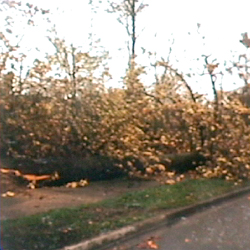 After that we went to the Power Lines [a Puget-Power
owned corridor for transmission lines that is full of woodlots].
The first thing we found was an alder lying across the trail.
It was a huge bushy strong one that snapped at the 5 ft. level.
We walked along the main trail heading north and found two
more fallen alders. As we walked the trail the wind increased
sharply, very sharply, I was almost blown down by the cold
gusts which roared through the trees with the sound of a jet
engine. We came to a four-lane intersection. There was a large
power pole west of us and there were trees all around us. The
wind picked up. I watched a cottonwood tree lose one of its
largest branches in the gust. Then a whole swarm of twigs flew
off behind it. We turned around to go home. As we walked along
the trail we saw an alder get uprooted with a deep ripping
sound and a flop to the ground like a dead fish. As we walked
past the tree that was once a magnificent tall cottonwood,
a gust completely impeded our progress (it had to be over 50
mph).
After that we went to the Power Lines [a Puget-Power
owned corridor for transmission lines that is full of woodlots].
The first thing we found was an alder lying across the trail.
It was a huge bushy strong one that snapped at the 5 ft. level.
We walked along the main trail heading north and found two
more fallen alders. As we walked the trail the wind increased
sharply, very sharply, I was almost blown down by the cold
gusts which roared through the trees with the sound of a jet
engine. We came to a four-lane intersection. There was a large
power pole west of us and there were trees all around us. The
wind picked up. I watched a cottonwood tree lose one of its
largest branches in the gust. Then a whole swarm of twigs flew
off behind it. We turned around to go home. As we walked along
the trail we saw an alder get uprooted with a deep ripping
sound and a flop to the ground like a dead fish. As we walked
past the tree that was once a magnificent tall cottonwood,
a gust completely impeded our progress (it had to be over 50
mph).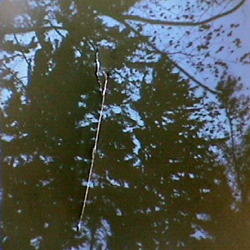 It was about 4:30 PM at the time. The wind blew
in long steady gusts and the trees groaned in it. The Douglas
firs swayed so far I thought they were going to fall. [Picture
to right was taken during a gust--the photo has a tare.] Branches
rained down on us and leaves were everywhere. I noticed that
the two storms up to that time had cracked seven tops off of
a cluster of twelve cottonwoods and alders at the south edge
of the forest, up the slope. In the excitement of the wind,
we started playing a game, leaping across the deeply incised
creek's shoreline. Derek ran across the creek bed and stopped
for an instant. Then he ran back. As he did so, a Douglas fir
that I was standing by (only 1 ft. away!) snapped in two and
made its long journey downward. [I remember clearly staring
at the falling trunk, dumbfounded by it's suddenness--the gust
it broke in didn't seem any different from the others.] Derek
jumped and ran right underneath it as it was falling and then
it slammed into a hill. We stayed a little longer to watch
the seemingly endless swarms of branches fall down and then
we walked home.
It was about 4:30 PM at the time. The wind blew
in long steady gusts and the trees groaned in it. The Douglas
firs swayed so far I thought they were going to fall. [Picture
to right was taken during a gust--the photo has a tare.] Branches
rained down on us and leaves were everywhere. I noticed that
the two storms up to that time had cracked seven tops off of
a cluster of twelve cottonwoods and alders at the south edge
of the forest, up the slope. In the excitement of the wind,
we started playing a game, leaping across the deeply incised
creek's shoreline. Derek ran across the creek bed and stopped
for an instant. Then he ran back. As he did so, a Douglas fir
that I was standing by (only 1 ft. away!) snapped in two and
made its long journey downward. [I remember clearly staring
at the falling trunk, dumbfounded by it's suddenness--the gust
it broke in didn't seem any different from the others.] Derek
jumped and ran right underneath it as it was falling and then
it slammed into a hill. We stayed a little longer to watch
the seemingly endless swarms of branches fall down and then
we walked home.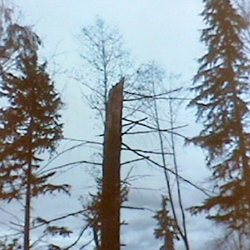 In The Forest on the other side of the
fence there was considerable damage done. on the edge of this
forest so many bows and branches were snapped off and thrown
around that this part of The Forest was almost impassible.
But with the help of a machete I made it through.
In The Forest on the other side of the
fence there was considerable damage done. on the edge of this
forest so many bows and branches were snapped off and thrown
around that this part of The Forest was almost impassible.
But with the help of a machete I made it through.